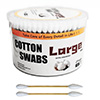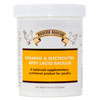Prolapsed Vent In Chickens: Causes & Treatment
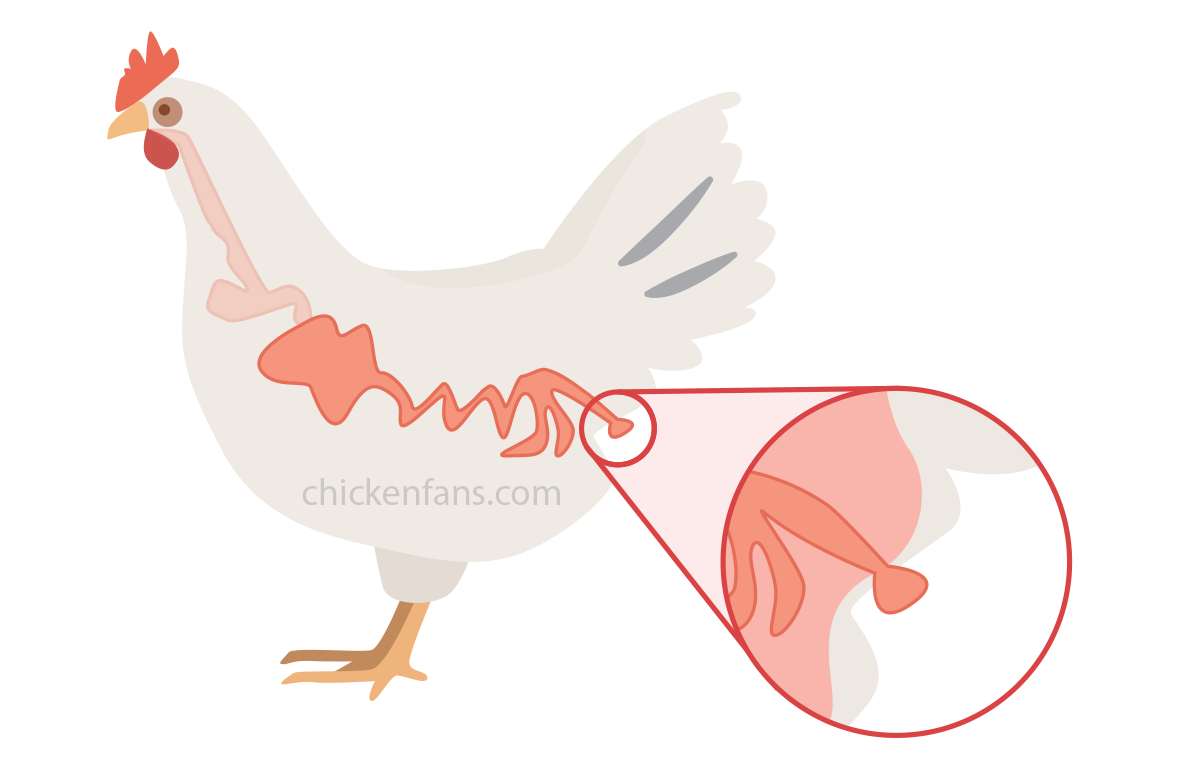

What is Vent Prolapse · Causes · Symptoms · Diagnosis · Treatment · Recovery · Prevention · FAQ
Noticing a prolapsed vent in your laying hens can be unsettling, to say the least. But hang tight – there are tools to fix it. Your two best allies are a squeaky-clean coop and a balanced chicken diet.
What Is a Prolapsed Vent in Chickens?
Prolapsed vent, also known as a vent prolapse or a ‘blowout,’ is a health issue where the chicken’s cloaca protrudes outside the body, making it vulnerable to infections. The cloaca is the opening at the end of the body where the reproductive, digestive, and urinary systems meet.
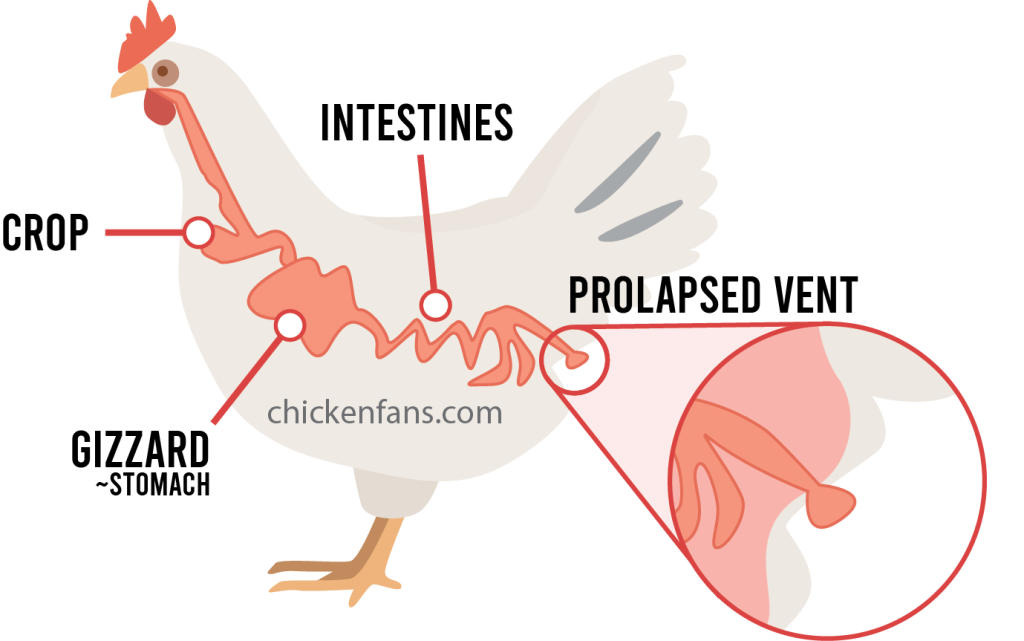
The scientific term for this complication is cloacal prolapse. It is more common in overweight chickens or chickens recently undergoing trauma, such as being pecked at by other birds. A part of the reproductive tract slightly goes outside a chicken’s body when it lays an egg but then retracts swiftly. If it doesn’t, the chicken develops a prolapsed vent.
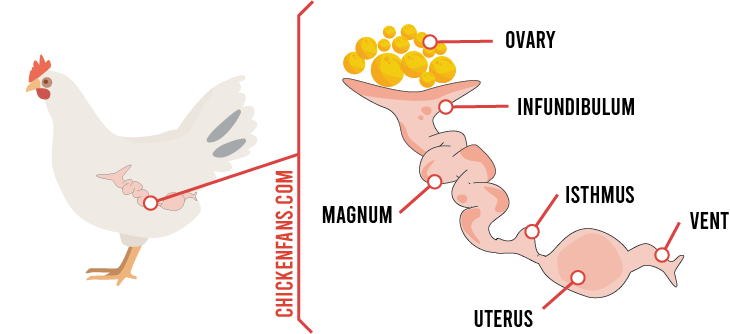
As you can imagine, an animal’s reproductive parts should never be outside its body, making the chicken incredibly vulnerable to contracting infections. The prolapse prevents them from properly eliminating waste, so early discovery is paramount when treating this health issue.
First Aid for Prolapsed Vent in Chickens
If left untreated, prolapsed vent in chickens will be fatal. It is often just a symptom of an underlying issue, but immediate action should be taken once the internal reproductive organs can be seen outside the bird.
These over-the-counter products are recommended as first-aid and preventive measures.
Causes of Prolapsed Vent in Chickens
The most common factors leading to prolapsed vent in chickens are:
- Obesity
- Overly large, irregular, or soft-shell eggs
- Too early egg-laying
- Oviductal diseases (e.g. egg binding, salpingitis)
- Cloacal diseases (cloacitis, IPD, Inclusion Body Disease)
- Stress, which can make a chicken hold its droppings for some time
- Cannibalism between birds leading to lesions of the vent
- Excessive photostimulation to stimulate egg-laying
- Underweight chickens trying to lay double-yolked eggs
- Nutritional deficiencies
- Constipation and dehydration (which often go hand in hand)
- Overpopulation
Chickens that are not given enough calcium in their diets not only develop nutritional deficiencies, but their muscle tone is also low, and the eggshell formation is disturbed.
If an egg is soft-shelled, a chicken has a hard time eliminating it, which is why it might strain and accidentally cause prolapse due to weak local muscles.
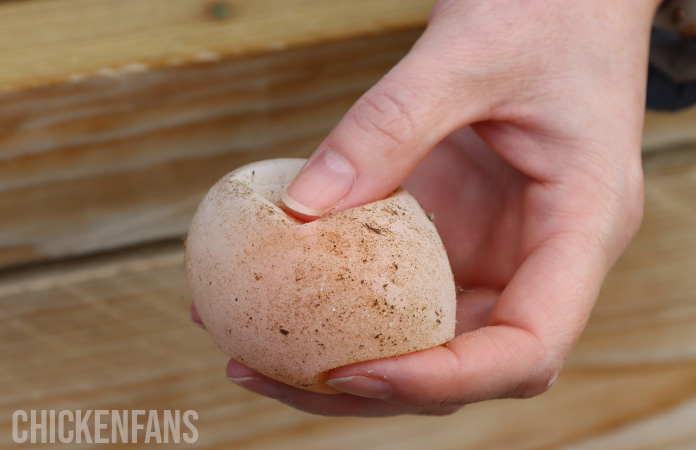
In general, a prolapsed vent is caused by excessive straining or a loss of muscle tone around the chicken’s vent.
Prolapse is more common at peak production periods or when farmers use high-intensity lighting in the coop to promote egg laying. Overpopulation leads to chickens being in close contact, and if they are mineral deficient, they might engage in cannibalism, which can both lead to prolapse and cause trauma to the prolapsed tissue afterward.
Symptoms of a Prolapsed Vent in Chickens
Typical symptoms of a prolapsed vent are:
- Internal reproductive tract protruding outside the vent
- Bloody or torn portions of the prolapsing cloaca
- Lack of appetite
- Lethargy
- Ruffled up feathers
- Increased aggression toward other chickens
- Sudden death in chickens experiencing extreme prolapse
These clinical signs can be grouped depending on the stage of the health condition. In the beginning, the chicken might lay eggs with streaks of blood on them or be seen straining heavily when laying eggs.
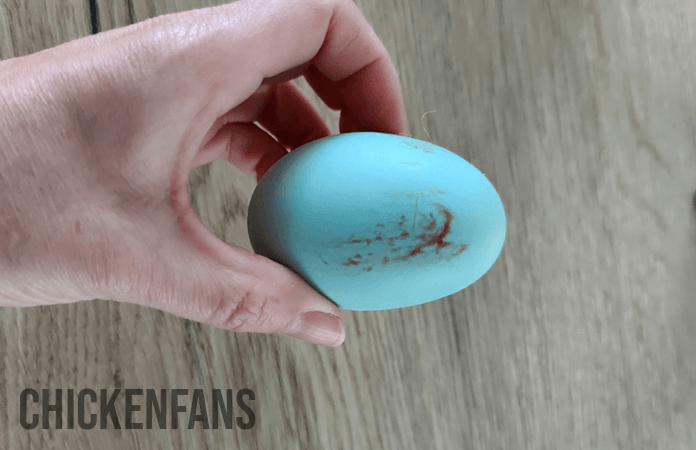
Self-isolation, unwillingness to eat, and a red and swollen cloaca are some of the first symptoms you can see, and that should convince you to separate the chicken from the rest of the bird population to treat it separately.
Diagnosis of Prolapsed Vent in Chickens
The first signs you’ll likely notice are that parts of the chicken’s rear area stick through its vent. This can be the inner lining of the cloaca, but in severe cases, it can also be parts of the rectum and oviduct.
Small prolapses need to be distinguished from papillomas. Papillomas are abnormal tissue growths or bumps that can appear in a bird’s cloaca, making it difficult for the chicken to poop or lay eggs. You can compare them to human polyps.
Making a difference is crucial because the treatment and long-term management differ.
A vet can use blood tests (hematology and biochemistry) and cloacal culture. Whole-body radiographs or cloacal endoscopy with or without biopsy may also be performed to identify the cause. Endoscopy may be valuable to follow the prolapse back into the body to identify the specific tissues involved (cloaca, rectum, or oviduct).
How to Treat a Prolapsed Vent in Chickens
A prolapsed vent can be treated as follows:
- Clean the vent area thoroughly
- Treat swelling and damage while holding the prolapse in place
- Put the prolapse back in place
- Stitch the vent to prevent future prolapse (by a vet)
- Provide antibiotics
- Nutritional supplementation
- Reduce stress factors
- Modify Light Intensity
- Treat underlying conditions
A chicken that has had prolapse before has a high chance of developing it again. As a result, they need more protection and must be kept separate from the rest of the flock. Use following first-aid products to start the treatment.
1. Clean the Vent Area
Place your hen in a warm bath and clean the affected area as gently as possible. Use disposable gloves. If the vent is completely prolapsed and it has been for a few good hours or even days, it’s probably dirty, or some of the tissue is damaged. Remove any debris to the best of your abilities.
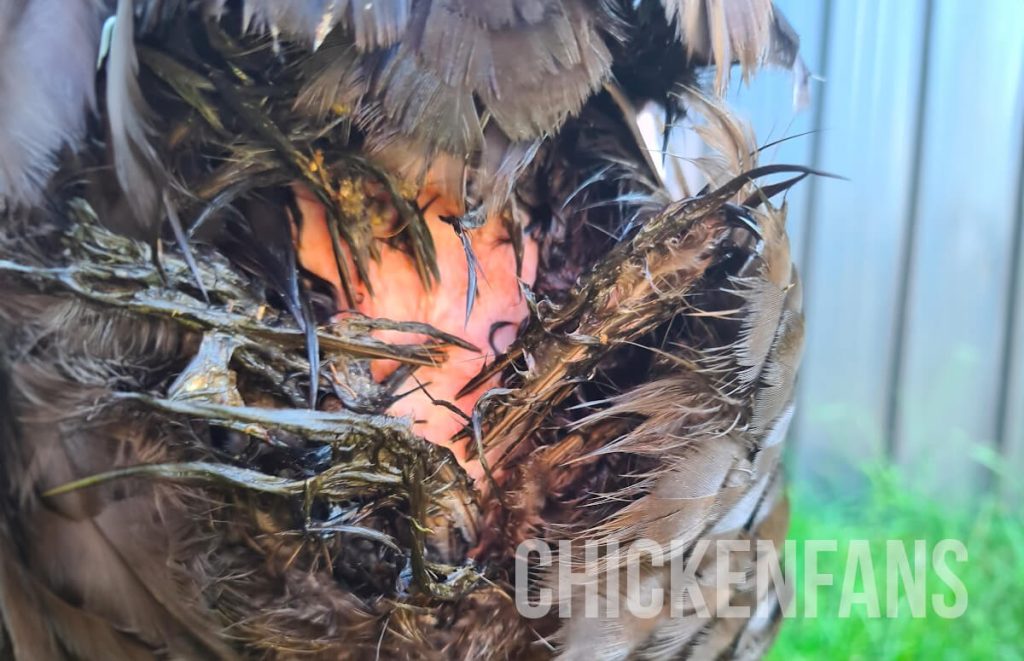
Try to use a moderate antiseptic in the bathing water, such as one containing chlorhexidine and not alcohol, or a spray such as Vetericyn. You can use petroleum jelly on the tissue or anti-inflammatory creams, but avoid ones containing lidocaine or local anesthetics.
Examples of anti-inflammatory medications you can use for chickens are carprofen, meloxicam, ketoprofen, piroxicam.
2. Treat Swelling and Damage
If the tissue that’s sticking out is swollen by accumulation of fluid, a vet can reduce the swelling by pouring sugar or glucose on the mucosa. This has an osmotic effect that helps draw out the extra fluid.
In severe cases, a vet will use general anaesthesia to clean the prolapsed tissue and treat it.
4. Put the Prolapse Back Into Place
Once you’ve cleaned the area properly, lubricated it, and treated your chicken for the pain and discomfort, you can push the protrusion back in. Do so gently using a finger.
You can also use wet large cotton swabs to gently push the tissue back to where it normally belongs, and then rinse it with saltwater to clean and puff it up a bit.
5. Stitch the Vent (by a vet)
If the area keeps protruding repeatedly, a vet can add stitches to keep it in place.
If you look at it, you’ll notice that a chicken’s vent isn’t actually round; it’s more like a small horizontal slit. A vet will put stitches on both sides of the chicken’s vent.
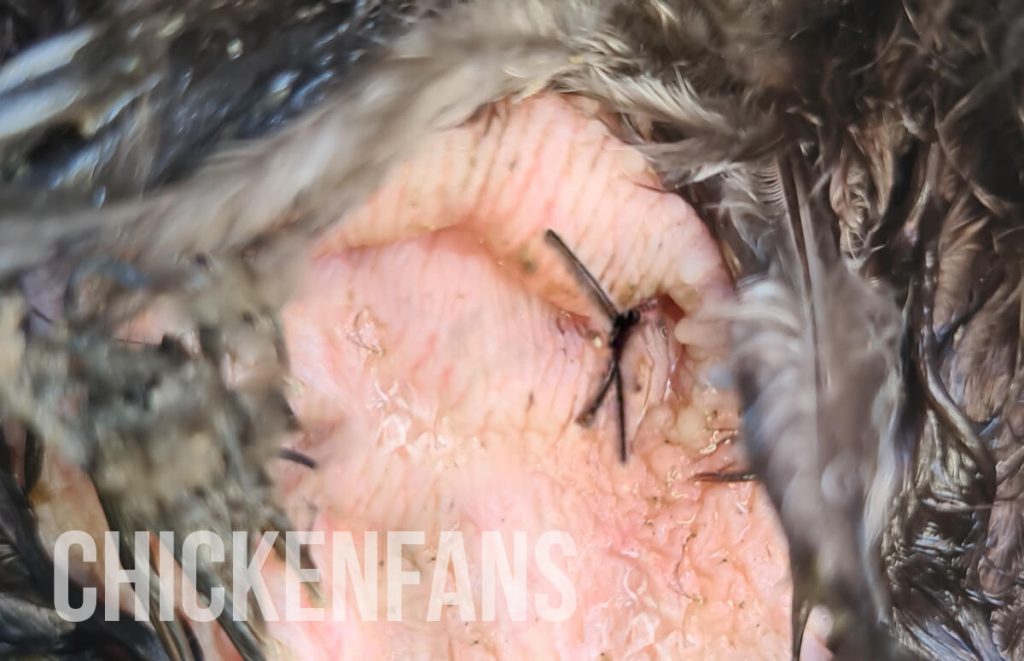
The goal is to make the opening smaller to help prevent future prolapses. However, it’s important that the opening is still large enough for the bird to comfortably pass waste and lay eggs.
6. Antibiotics
Medicated sprays such as Oxytetravet can prove their worth for affected areas. The antibiotic in this product (oxytetracycline) is effective against multiple bacteria that might have had access to the chicken’s prolapsed vent, such as:
- E. coli
- Pasteurella spp. (causing a disease known as fowl cholera)
- Salmonella spp.
- Mycoplasma spp. (causing chronic respiratory disease in chickens)
- Fusobacterium necrophorum
6. Nutritional supplementation
Adding vitamin C to the chicken’s drinking water and calcium into their premixed food is a great way to provide them with the right nutrients their muscles need to recover.
This is particularly necessary if the chicken is underweight and they developed a prolapsed vent in the first place by laying overly large eggs.
7. Modify Light Intensity
If you’re keeping chickens for their eggs and you want them to keep laying during winter, you need to ensure that the amount of light they receive in the barn or coop is in accordance with their necessities.
In other words, overdoing it is bad for their health and makes them experience a lot of stress. Even when it’s summer, it’s not normal for animals to have access to light for more than 16 to 17 hours a day. Ideally, you should aim at less than 14-15 hours a day, even if this negatively influences egg production.
To promote a comfortable egg-laying experience, all of the nesting boxes need to be in somewhat dark places, not to mention that the dark itself makes it less likely for a prolapsed vent to be attacked by other chickens.
8. Treat Underlying Conditions
Vent prolapse is often just a symptom of an underlying issue. If diseases like egg binding, salpingitis, cloacitis, IPD or spinal cord diseases are the root causes, they must also be treated to prevent recurring prolapses.
Simply pushing the tissue back in place won’t solve the problem if these underlying conditions remain untreated.
Steps to Take for Recovery
Here are a few measures to consider after you’ve successfully treated a chicken’s prolapsed vent:
- Separate the chicken from the rest of the flock and keep them separated for a week or two.
- Inspect your chicken’s vent daily for any signs of inflammation, redness, or protruding tissue.
- Avoid exposing your chicken to too much light, which can promote egg laying and irritate the reproductive parts.
- Create a temporary home for your chicken next to the coop or inside your house.
- Ensure the bird has access to plenty of fresh water (to prevent constipation), to which you can add apple cider vinegar and vitamin and mineral supplements.
- Avoid foods that promote egg laying, such as big amounts of grains, mealworms, or sunflower seeds.
- Feed them primarily vegetables, fruit, and grains. For protein necessities, you can give your chicken some legumes now and then.
Can You Prevent a Prolapsed Vent in Chickens?
Yes, prolapsed vent in chickens can be prevented, which is much better than treating it. Especially since not all birds respond well to the therapy once it is initiated. If the prolapse isn’t noticed early on, the tissue might suffer some damage by other birds or get dried up and necrotized, leading to possible life-threatening infections.
Here’s how to prevent your chickens from experiencing a prolapsed vent:
- Supplement with minerals and vitamins regularly, even after they become adults.
- Make sure you have the correct number of chickens in your flock and they can’t hurt each other.
- Monitor their intake of food and water and ‘bathroom habits’ to the best of your abilities.
- Do not provide additional light, particularly in the winter.
- Ensure your chickens have access to a comfortable, clean, private, dark place to lay eggs.
- Never allow your chickens to become overweight, as this promotes prolapse more than anything else.
Frequently Asked Questions
It depends on the severity of the complication. Some parts of the reproductive tract protrude outside a chicken’s body when they lay an egg. But they are retracted back to the inside immediately. If a prolapse lasts over an hour, it can’t fix itself anymore, and you must intervene.
Once a chicken is treated for prolapse, it can live a healthy life. However, if left untreated, the outcome will be fatal. When a chicken experiences a prolapsed vent, it bears the protruding tissue on the ground, subjecting it to potential harm from other chickens who might peck at or trample it. A chicken can’t live with an untreated prolapsed vent over the long term.
Any type of food is allowed so long as it doesn’t promote egg laying. Fruits and vegetables are the best food source, and if you can supplement your bird’s diet with vitamins and minerals, they’ll have access to the proper nutrition.
Prolapse is quite common in overweight and obese hens and very young and small chickens that have just started laying. In some cases, the oviduct becomes damaged as the chicken is laying a large egg, which can also contribute to developing prolapse.
Summary
Also known as cloacal prolapse or a ‘blowout,’ a prolapsed vent is a condition that affects laying hens. Some of the causes of this health issue range from laying large eggs to cannibalism, excessive photostimulation, and nutritional deficiencies.
Symptoms range from laying eggs with bloody streaks on them to the actual reproductive tract protruding outside of the vent, along with general clinical signs such as lack of appetite for food or water and lethargy.
In cases that are not severe, prolapse in chickens can be treated with locally cleaning the affected tissue and placing the prolapse back into its place, antibiotics, anti-inflammatory medication, light intensity changes, and nutrient supplementation.

Dr. C. Vulpe is a credentialed veterinarian and holds a Ph.D. in veterinary oncology. With over a decade of experience in veterinary medicine, Dr. Vulpe loves giving practical and easy-to-follow advice to homesteaders, chicken lovers, and pet owners across the world. Her scientific work has been showcased in multiple publications.
Related Articles
- Chicken Digestive System: A complete overview of the chicken’s digestive system, including the cloaca and vent
- Chicken Reproductive System: a complete overview of the chicken’s reproductive system, including the vent and the oviduct
- Chicken Egg Abnormalities: an overview of common egg deformities and what’s causing them
- Egg Binding: egg binding in chickens, a possibly life-threatening situation
- Salpingitis: lash eggs in chickens, treatment and overview of salpingitis
Want to learn more about the health issues of chickens and how to prevent or treat them? Check out our Health Page, Symptom Checker, and Chicken Behavior list.
Resources:
- Which NSAIDs are for the birds?, Joanne Paul-Murphy, DVM, DACZM, DACAW, American Association of Zoo Veterinarians Conference, 2013: https://www.vin.com/apputil/project/defaultadv1.aspx?pid=11388&catid=&id=6046978&meta=&authorid=
- Prolapse of the Oviduct in poultry, Rodrigo A. Espinosa, DVM, DACPV, Aviagen, 2019: https://www.merckvetmanual.com/poultry/disorders-of-the-reproductive-system/prolapse-of-the-oviduct-in-poultry
- Management and medicine of backyard poultry, Patricia Wakenell et al, 2016: https://www.ncbi.nlm.nih.gov/pmc/articles/PMC7152007/#:~:text=%E2%80%9CVent%20blow%2Dout%E2%80%9D%20or,which%20will%20often%20prevent%20retraction.
- Reproductive Disease of the Backyard Hen, Cheryl B. Greenacre, DVM, 2015: https://www.ncbi.nlm.nih.gov/pmc/articles/PMC7106171/
- Asymmetrical Cloacoplasty for the Treatment of Chronic Cloacal Prolapse in Psittaciformes: A Case Series, Omar Zaheer et al, 2020: https://pubmed.ncbi.nlm.nih.gov/32702957/
- Emergencies and Critical Care of Commonly Kept Fowl, Mikel Sabater Gonzalez et al, 2016: https://www.ncbi.nlm.nih.gov/pmc/articles/PMC7110600/

